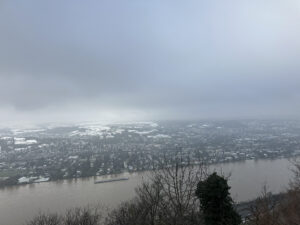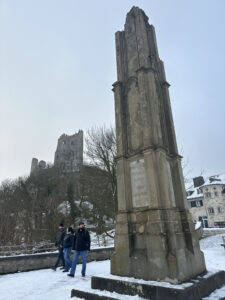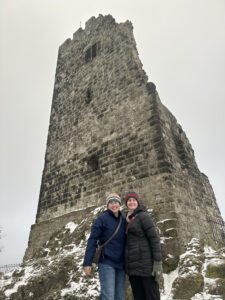The History Behind Dragon Rock Ruins

If you ever find yourself in the town of Königswinter, Germany located 40 minutes outside the City of Bonn I would recommend taking a trip across the Rhine and taking a visit to the Drachenfels Ruins. Its fascinating history and beautiful view makes it the perfect place to go to when it is warm or cold out!

History of Drachenfels
The Drachenfels Ruins, also known as Dragon Rock, are located at the top of Drachenfels in the Siebenbirge uplands. This area was originally mined for its trachyte dating back to Roman times. Around the year 1000, stones from here were used to build the Saint Maria im Kapitol church in Cologne around the year 1000. In 1138 construction began to build Burg Drachenfels which was completed in 1149. It was intended to help defend the city of Cologne from invasion. During the Thirty Years War in the 17th century, the fort got severely damaged when the Swedes attacked. It never was rebuilt as it lost its strategic importance and the lord of Drachenfels was not interested in repairing it.
Once the Drachenfels railways were built in 1883, access to the ruins became much easier making it a popular tourist location. It also became popular due to the various legends around the ruins. One of the largest legends around Drachenfels stems from the Nibelungenlied, which is a series of epic poems similar to the Iliad and involves the hero known as Siegfried. It is said that Siegfried slayed the Dragon Fafnir in a cave found at these ruins and then bathed in the dragon’s blood. This made him invulnerable except for one spot that was covered by a leaf, which is what led to his demise later in the story.

My Experience
There are a few ways to reach the top of this hill. If you are interested in hiking there are trails that will lead you up to the top though it can get a bit steep at times. However the view from the top makes the hike ten times more worth it. You can also take the train all the way to the top if hiking is not something you are interested in. Though it does cost about 9 euros for a round trip. The train was originally powered by steam though it was switched to electricity in 1958. For a while you could also ride a donkey up to the top of the hill, though that is not offered anymore.
I hiked up to the top with my host family and friend Maya. I recommend hiking up if you can because of the sights you see along the way. On the way up my host family told me and Maya about the legend behind the ruins as well as its history. You pass a reptile zoo and murals depicting the donkeys that would bring you up the hill. While hiking up you also pass the Schloss Drachenburg castle which is now a museum open year round. The outside of the castle was beautiful and while we did not go inside, it was highly recommended to also go visit it when we get the chance. The train will also stop by the castle for those interested as well. The rest of the way you go up on trails which were a little slippery from ice due to it snowing a few days before.
On the way up I noticed that the cliffside had concrete scaffolding against the rocks. I asked my host mom about it, and she told me that these spikes were used to protect the rocks from collapsing. After doing more research I learned that after a rockslide in 1970 this scaffolding system was built and now more than 170 spikes sit along the cliff’s edge. Without them, the upper sections of the hill which includes the ruins would have fallen a while ago. While this isn’t a permanent solution it is what lets tourists still be able to see these ruins today.
Once you reach the base of the ruins, that is where you can find the train station and a small cafe to get food and souvenirs. After stopping to admire the view you can continue up the stairs to the top of the ruins. Both of these spots give you a wonderful view of the Rhine and the valley. Getting to see the ruins up close was also a very cool experience which made the hike so worthwhile.
Conclusion
Learning the history and legends behind these ruins was a very fun experience. Getting to see it in person adds a whole new layer as you can understand the story of how the ruins got to this point and appreciate them even more. Seeing it go from a place of defense to protect people to becoming a place for tourists to visit is a fascinating experience. Especially when you learn about how modern day infrastructure was used to help preserve the ruins and is the reason why it is still standing today. Since we went during the winter season, there were less tourists compared to the spring, so it made the experience more personal and peaceful. Going when it is warmer is not bad either and I definitely plan on returning in the spring to see how the view changes. Once again I would highly recommend visiting this place if you are a fan of castles, history, or hikes!
-Samantha
Sources
https://www.middle-europe.cz/the-legend-of-drachenfels-dragon-rock/
